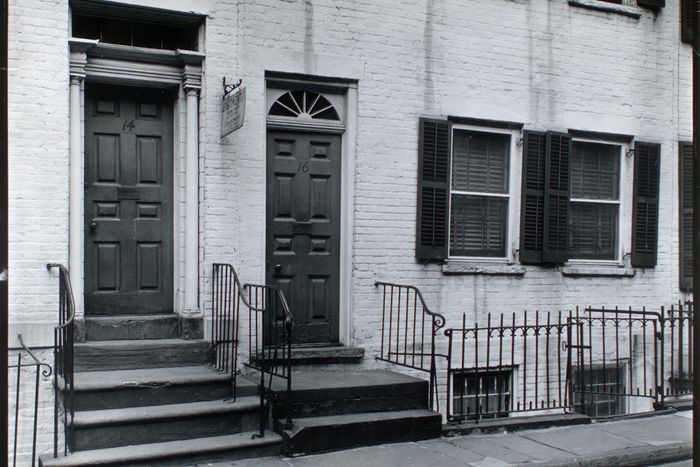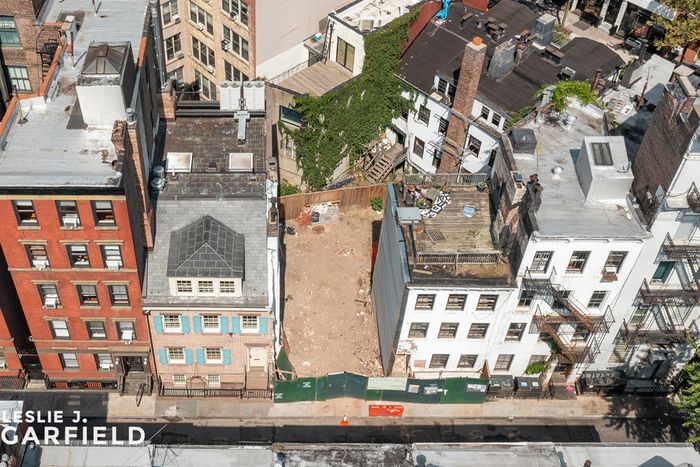A Frankenmansion Is Coming to Greenwich Village’s Gay Street

Fourteen Gay Street, the landmarked Greenwich Village townhouse that was demolished after construction work destabilized its foundation in 2022, is entering its next era: megamansion. The now-empty lot and neighboring 1,800-square-foot townhouse at 16 Gay Street (also landmarked) have been sold for $4.9 million to Gay Street Revival Initiative 1 and 2, a pair of limited-liability companies linked to Vladlen Koltun, an Israeli American computer scientist who works at Apple. When the properties went on the market for $6.64 million last August, the listing marketed them as a potential 40-foot wide, 4,500-square-foot single-family home. Matthew Lesser, one of the Leslie J. Garfield brokers who had the listing, confirmed that the buyer intends to build a new single-family home at the site.
A close-up on 14 and 16 Gay, both landmarked, only one still standing.
Photo: Berenice Abbott via NYPL Picture Collection
Until a few years ago, the properties were part of the real-estate portfolio owned by Celeste Martin, an eccentric landlord known for her eclectic tenants, her generosity — she would waive rent for those “in extremis,” according to the New York Times, and delivered Christmas gifts of pink Champagne and sweets — and a lackadaisical approach to maintenance. She died in 2018, at 94, without a will or any direct relatives, and the city sold the six buildings she owned on Christopher and Gay Streets for $9 million. (Martin also owned a handful of other Village properties, including the pink house at 114 Waverly Place, which Bob and Cortney Novogratz bought from the city after her death.) That new owner flipped the Gay Street houses to developer Lionel Nazarian for $12 million in April 2022, and he set off on a heavy renovation.
The work, says the city, violated Landmarks and DOB rules, and undermined the foundations of No. 14. Bob Nazarian calls it all a terrible mistake; assemblymember Deborah Glick and Andrew Berman, of the Greenwich Village Society for Historical Preservation, have suggested that it may have been deliberate — the buildings were in bad shape, needing work that Nazarian admitted was going to be “more expensive than I thought,” and it was easy enough to imagine that he’d just done whatever he felt like doing and then declared an oopsie.
An overhead view of 16 Gay and the now-empty lot where 14 once stood, as shown in listing photos, where the buyer can build a new 40-foot-wide 4,500-square-foot house.
Photo: Leslie J. Garfield
The city issued emergency stop work and vacate orders on November 7, 2022, deeming No. 14 “in danger of immediate collapse” and No. 16 structurally compromised, and erected an emergency construction fence to protect the public. Preservationists staged a protest vigil, demanding that Nazarian undo whatever he’d done, but No. 14 was declared unsafe by the city and came down, erasing one more piece of unrarefied Village history. The townhouses, which date (or rather dated) to the 1820s, weren’t grand: They were intended for the mercantile class, the architectural historian Andrew Dolkart told the New York Times, remnants of an era when “shop owners and small business owners could afford to live in a single-family home in a built-up section of Manhattan.” Later, as many Village townhouses were broken up into cheap apartments for artists and writers, Martin’s father divvied the buildings up into furnished studios. He saw himself as both an artist and budding real-estate mogul, and inspired the Greek landlord character Mr. Appopolous in My Sister Eileen, a collection of stories written by onetime tenant Ruth McKenney that became the 1950s musical Wonderful Town. In 2003, a terrible fire in the building killed the tenant who lived in McKenney’s old ground-floor apartment; he and Martin, who’d been friends, had gone to see a Broadway revival of Wonderful Town only a few weeks earlier. She never repaired the unit, leaving it to rot instead.
The Bohemian era was already all-but vanished by the time Martin died. (There is still at least one performing-artist tenant in a neighboring building that Martin owned, but he told me his neighbors had all been bought or driven out.) The West Village era of hedge funders and tech titans is now upon us: Sean Parker has a triple-wide on West 17th, biotech hedge funder Felix Baker owns the 15,000-square-foot former charity foundation at 27 Christopher, and Steve Cohen built a megamansion at 145 Perry Street.
The yet-to-be-built property at 14-16 Gay Street is, in such company, practically modest. While 40 feet is wide, 4,500 square feet is the size of a normalish Greenwich Village townhouse. Because it’s in a historic district, the new house will have to clear Landmarks approval and conform to the neighborhood’s scale, but it is almost sure to be melded with the house at No. 16, retaining little historic integrity besides its façade. Koltun did not respond to requests for comment, so we won’t know the details of what he’s intending to do with the property until plans are filed with the city. Whatever it is, it won’t need to be constructed with materials from the demolished building, as preservationists had called for. Those were deemed unsalvageable, with the exception of the door.
Source link






